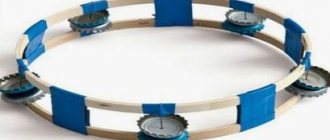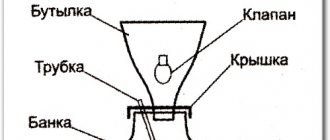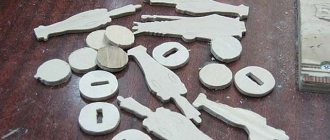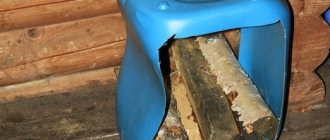Home→Household Appliances→How to make a carriage from wood. A DIY carriage is a fabulous gift for anyone
The life of a modern rural resident involves running a household. And the horse, as the main assistant, still successfully competes with such a technical unit as a tractor. Harvesting hay, collecting milk, transporting building materials, or simply moving off-road is not possible without a cart. It can be harnessed both with light and light harnesses. This article will discuss a very important issue - how to make a horse cart with your own hands.
A cart is a cart that draws cattle and horses. A cart is often called a horse-drawn carriage. This type of transport has every right to move on public roads, where traffic rules do not prohibit it.
There are several types of horse carts:
- drogues;
- shelves;
- cart.
A drog is a cart without a body. As a rule, this is a fairly long cart. Shelf is a rather outdated name for a cart that has a flat floor and is used for transporting large items. A cart is a small carriage that has a seat, as well as a goat - a place where the driver sits.
Droggy
It should be noted that there are also decorative carts - carriages. Mainly used for walking, photography, etc.
Travel and body are the main components of a horse cart. The stroke is all the elements of the mechanism that set the cart in motion. The body is the actual trailer or cart and its components.
Swivel unit
In past times, all elements of the cart were predominantly wooden. Even the wheels were made of wood. Today, thanks to great opportunities, many parts of the cart are made of metal.
Move
A move consists of the following elements:
- Axles – front and rear. On each axis there are so-called superstructures that strengthen the axis.
- There are two wheels on the front axle and two on the rear axle. It should be noted that often the front wheels have a smaller radius relative to the rear wheels.
- The struts - front and rear - functionally act as shock absorbers.
- Dissolution is an element that provides connection between the axes. The dissolution is attached to the racks, on the one hand, tightly, on the other - with the possibility of adjustment, which allows you to change the length of the cart by changing the distance between the axles.
- Shafts are attached to the front axle.
Before you start making a cart with your own hands, you should decide for what purposes it will be used, since, for example, to make hay it is necessary to make the elements of the cart from lumber, and the choice of wood will be important in this matter. Typically, well-dried hardwoods are used for these purposes. Pine is not suitable for this.
If the horse cart will be used primarily for transporting large heavy loads, it is necessary to use durable materials, such as metal, etc. To independently manufacture a cart used for pleasure purposes, you can use decorative materials, for example, plastic.
Metal material
For an inventor who loves to make things with his own hands, it will not be difficult to answer the question: “How to make a cart for a horse”? This task can be done by anyone who is willing to spend some time, think a little about the solution and find the necessary material, for example, unnecessary household items from a car, bicycle or old stroller.
What is a cart, its types
A cart is a cart pulled by harnessed cattle. A cart can also be called a horse-drawn carriage. This method of transportation is permitted by law on public roads.
There are three types of cart:
A long cart without a body is called a drog. The cart is used to transport people. It has seats for passengers and the driver. Shelves are used for transporting large items.
Modern carts - areas of use
In the modern world, three types of carts are used. The first type is a passenger cart. It is often used by both ordinary rural residents and city dwellers. In some areas, carts are the main method of transportation.
The second type of cart is a cargo cart. Thanks to its strong composition, it can transport various heavy loads. If a person has a horse, then he does not need to hire a car to transport things or hay.
How to make a simple horse cart with your own hands
To start making a cart, you need to think carefully about how to make all its elements. It is important to make the chassis of the vehicle correctly, since this is its main component. It includes:
- Front and rear axle,
- Frame,
- Wheels,
- Shock absorption struts.
The front axle must be made so that the cart can turn, and the rear axle must be stationary. If you are making an arc one-horse cart, then you need to pay special attention to making the shafts. For a steam-horse cart, the main element is the drawbar.
How to properly harness a horse to a cart
It is not enough to have a cart and a horse, you need to be able to use them. It is important to harness the horse correctly. This helps to avoid injuries, breakdowns and improve performance.
First comes the preparation:
- The harness and cart are checked. Even small abrasions on ammunition belts are not allowed, as this can lead to chafing and injury. If necessary, lubricate the wheels. If the vehicle is not in good order, the risk of overturning on potholes increases greatly.
- The horse is examined and cleaned, and the pet’s mood is assessed. If touch is unpleasant to him, health problems are possible. If the horse is anxious or unwell, it is advisable to reschedule the trip.
With a shaft-arc harness, the horse is assembled for the journey as follows:
- Adjust the tugs.
- The saddle and abdomen are fixed on the shaft. The first one sometimes injures the skin. If there is no saddle, then it is not used.
- They put on a bridle. The snaffle bit (pin) is heated in cold weather so as not to injure the horse.
- They put on a saddle. At first - a little higher, then lowered.
- Next comes the girth.
- The clamp is selected for each horse. Too small ones are not used. If they are too large, felt is sewn inside. Put them on first with the pliers facing up. Turn over on the narrow part of the neck.
- They stretch out the harness and straighten it. The belts are not tightened too much. There remains a palm-thick distance between them and the animal’s body.
- They lead you into the shafts. If the horse refuses to cross the pole, they force him to go backwards or roll the shafts.
- Fix the arc. Stand in front of the horse and lean a piece of harness against its right leg. Adjust the length of the tug: twist it. They place the shafts to the edge. Place the left edge of the arch into the loop of the tug. The second is thrown over the shaft and secured. They check. Next, turn the arc with a notch towards the second shaft. Place a tug on top. The loop ends up on the arc. Tighten the clamp.
- The soup is wrapped around the pincers. If necessary, lengthen the tug. The pincers connect at right angles. If this is not the case, the tug, on the contrary, is shortened.
- They throw on the reins. Attach the lanyard. Make sure that nothing prevents the horse from raising its head.
- They throw the belts over the shafts. They shouldn't be loose.
- The reins are threaded through the middle of the arc from the outside. Fastened to the bridle.
- They check the work. The tugs should be behind the arc. To check if everything is in order while moving, lightly touch the cart.
Horse carts are still in demand. They remain useful transport in both agriculture and tourism. Some models can be made with your own hands.
Despite technological progress, which has long been firmly established in human life, in remote areas of our country horses are still used in farming. These animals often perform draft work to transport goods. From the outside it seems that there is nothing difficult about harnessing a horse, but this is not so. Today, only a few know how to do this correctly.
Only after learning all the intricacies can you learn how to properly harness a horse to a cart, transport loads, plow the land, or simply take a walk in a carriage. Once upon a time, almost every locality had its own craftsmen who made vehicles. But today, a good crew will have to be bought or made independently, and the first option is preferable to the second.
Required materials and their quantity
Before you start making a cart, you need to have the following materials and tools:
- Tools for welding work,
- Wooden boards,
- Pipes or metal profile,
- Welded frame and metal wheels,
- Hammer,
- Nails,
- Cart drawings,
- Tool for working with wood.
The amount of material will depend on the size of the cart, its purpose and type. Most often, the cart is made from wood. The width of the cart should be 1.5 meters and the length - 3 meters. The height of the cart is adjusted to the meter, but you need to take into account the size of the horse and the purpose of the cart.
Rules for harnessing a horse in a Russian harness
If we talk about the shaft-arc harness, then this particular option belongs to the classics and is purely Russian. Before you start putting the horse into the cart, you need to have an idea of what elements are included in the Russian harness:
If we talk about a horse collar, it is selected individually for each horse. It should be close to the horse's shoulders. A collar that is too large can be narrowed slightly on the inside by sewing felt. But it is absolutely forbidden to wear a small collar. To use a saddle strap, be sure to wear a saddle so that the thin strap cannot rub the skin, because during harnessing it goes through the top of the saddle.
All parts of the harness must fit the horse; harness that is too tight or too loose can lead to injuries and accidents. The same applies to the means of transportation. Before work, it is necessary to check the integrity of the cart and the operation of the brakes.
After everything has been checked, you can harness the horse and it is best to do this under the strict guidance of a specialist. If the harness is put on in the stall, then everything starts with the bridle; if at the junctions, then the bridle is put on at the last moment.
The saddle is placed on the back so that its front part is above the withers. The girth is tightened so that 2 fingers can hardly fit between the horse.
The collar is put on with the pincers up and turned over directly in the narrow part of the horse's neck. Then comes the turn of the harness, which is carefully straightened and placed on the back.
When loading the cart, it is important to remember that the end of the shaft should be located next to the tugs. The interlace is secured through loops on both sides. Holding the left tack, insert the arch into it, and then move it over the horse's neck. If necessary, the tugs are twisted so that the arc does not jump out of them.
At the next stage, the clamp is tightened so that the clamp pliers come together. If something doesn’t fit, the tugs are adjusted. Here you need to attach the reins in one of two ways, depending on the horse’s performance. Secure the underbelly and gills. The horse harness is completed.
But there is no need to do this based on bare theory. It is better to ask advice from practitioners, otherwise it may end badly.
There are no similar posts
Drawing with comments
To make a cart, you first need to make a drawing of the cart. It has this general appearance.
If you divide it into parts, then it consists of an axle, a frame and a hinged assembly. The cart axle looks like this.
Now we need to make the frame.
At the end, you need to make a mounted assembly.
This is what the step-by-step structure of the cart looks like. When making a drawing, you need to know the dimensions of the cart and figure out what shape it will be. If you have drawn the drawing correctly, then it will be easier for you to make the cart.
Dimensions
An important point in this matter is the size of the cart. Our ancestors adhered to approximately this dimensional ratio - cart length - 3 m, width - 1.5 m. Height can vary from 0.5 m to 0.7 m. You can trust the experience of the times and take these dimensions of the cart as a basis.
- The main load-bearing element of the future structure is the frame. Thanks to the modern abundance of materials, it will be convenient to make a welded metal frame from a U-shaped profile. The frame consists of spars (longitudinal elements) and cross members. According to the size of the frame profile, it is necessary to select and insert bars, to which the flooring will then be attached - the loading platform of the cart.
U-shaped frame
- The racks, front and rear, are welded to the frame. In turn, the upper turntable is welded to the front pillar (bottom), and the lower turntable is welded to the front axle (top). An oiled felt disc is placed between the turntables. This whole structure works as a sliding bearing when turning.
- The axles of the cart can be made of metal - a small diameter pipe is ideal. A wooden beam is also suitable for these purposes. In this case, holes of sufficient length should be made at the ends of the beam into which the pins will be inserted. Washers are put on the axle, and the wheels are secured to the studs with nuts.
- The choice of wheels for a cart depends on the purpose for which the cart will be used. Therefore, you can use wheels from an old bicycle, motorcycle or trailer that is no longer needed on the farm.
Wheel selection
- Shafts are attached to the front axle of the cart.
- Making a body is a process that directly depends on the imagination of the craftsman. The most versatile is a cart in the form of a platform - for comfortable transportation of goods. The base can be equipped with folding sides or removable. If you intend to transport passengers, you can equip the structure with soft seats.
It’s hard to imagine ordinary life in remote Russian regions without the use of horses for farming. That is why a cart and the ability to harness horses are simply necessary here. Very few people now know how to harness a horse correctly. Experienced specialists can learn how to harness a horse.
Under their guidance, you can figure out how to harness a horse, how to use a cart with a horse to bring any cargo, firewood from a forest belt, plow a plot of land or go to a neighboring village. In the old days, in almost every village there was a special cart-maker. Nowadays, it must be purchased or made with your own hands.
Russian harness is a special type of horse-drawn transport and is manufactured in several configurations. Therefore, it is necessary to decide in advance on its type and main purpose.
If it is needed only for work on moving various cargoes, then you can make a simple road or cart in the form of a platform, in other words, without sides and with a flat bottom
. When a cart is needed to move hay, other loads and for use as a vehicle, then it is worth making one with large sides.
Additionally, it is necessary to think in advance about how many horses will be harnessed to the collar. Because double-horse and single-horse harnesses are quite different in technology
manufacture and intended use.
A two-horse cart has a drawbar and a clamp, while a single-horse cart is equipped with an arc and shafts
. In cases where it is planned to manufacture a Ukrainian model, a cart or a drawbar cart is used in the same way, regardless of the number of harnessed horses. It is worth noting that it is easier to make a drawbar harness with your own hands, unlike an arc cart.
It is difficult to imagine village life in the outback of our country without a faithful and reliable assistant - without a horse. Therefore, here you will need both a cart and a sleigh for the horse in winter, when it gets snowy. You can bring cargo on horseback, firewood from the forest, plow your garden, and just go to the market off-road. Previously, almost every village had a cart and sleigh maker. And today you will have to either buy them or make them yourself, which we will talk about in our article.
[Hide]
Manufacturing instructions, with secrets and nuances
You can make a horse cart from wood or iron, but we will talk about how to make a wooden cart. The work consists of three stages.
- Make an axle from timber. Some people find it difficult to make an axle out of wood on their own, so they hire specialists to do it. You can learn more about how to make an axle from the video.
- Make a frame. To do this, you need to take a beam and attach a beam to it, on one side, and a turning mechanism on the other. The rear axle must be attached to the frame frame. After this, assemble the turning mechanism. For strength, attach additional bars to the sides of the axle.
- We are making a hanging assembly. Attach the bottom of the cart to the frame frame. You need to attach two boards to the edges of the bottom. After cutting out the end of the cart, attach it to the frame. You need to attach two boards to each end. We hook the wheels and fasten the shafts.
So our cart is ready. It can be decorated with wood carvings. If you want, attach seats to it.
Assembly
In the presented photo you can see all the components of the cart.
The process begins with the manufacture of wheel axles. First of all, the rear axle is manufactured, since it has a simpler design. It can be made of wooden beams with a cross-section of at least 150x150 mm, as well as from a metal square profile. The second option is preferable, as it has low weight indicators and a higher percentage of safety margin.
Metal bushings are attached to the edges of the axle, onto which the wheels will be placed. They can be used as axle bushings from the front wheels of a motorcycle. They are manufactured using technologies that provide the best performance.
The bushings can be secured to the edges of the rear axle using a welding inverter and additional spacers. Before mounting the wheels, bearings of the appropriate diameter are selected.
The front axle is assembled according to a similar scheme. The main difference between the front axle and the rear axle is the presence of a turning mechanism in the first one. Its assembly requires special care and precision.
A vertical rod equipped with a bearing is located strictly in the center of the front axle. The rod configuration is similar to that of wheel hubs. A bearing of the appropriate diameter is placed on it.
A special strip with a hole in the center is placed on top of the front axle. This hole is for the rod. The top side of the hole in the strip must be drilled out to create a pocket into which the lock nut will fit.
After the rod is threaded into the strip hole, a nut is screwed onto it. Thus, the front axle is connected to the bar through the rod. At the same time, the possibility of rotation of the front axle relative to the bar remains possible. It is carried out by a bearing mounted on a rod, which is located between the axis and the axial bar.
After this, it is necessary to permanently attach the bar to the bottom of the cart body. To make this task easier, you can rotate the axle 90 degrees relative to the axle bar. Then through holes are drilled in the bar, which also pass through the bottom of the housing. The diameter of one hole should not be less than 10 mm. Bolts are inserted into them, the rounded heads of which should point upward.
After the washers and screws are put on the bolts, the nuts are screwed onto them. The integrity of the rotating mechanism will depend on the number of mounting bolts and the degree of their tightening.
The body is made from dried wooden boards. It consists of a bottom - a boardwalk connecting the wheel axles, and three sides. Typically, a front side board is not required, since its presence interferes with comfortable control of the cart.
The general appearance of the cart body has the outline of an inverted trapezoid. The sides are installed in such a way that their lower components are at a smaller distance from each other than the upper ones.
This arrangement allows you to increase the capacity of the cart and narrow the width of the bottom, which, in turn, makes it possible to shorten the axle bar.
Steering poles are attached to the front axle at an equal distance from its center. To attach the poles to the axle, sections of round pipes with a length of 20 to 25 cm are welded. Side holes are made in them into which through fastening bolts will be inserted.
Poles are inserted into the welded sections of pipes, the diameter of which is several units less than the diameter of the pipes. The difference in diameter allows the poles to move vertically up and down, which is necessary when attaching them to the harness. In those parts of the poles that are inserted into tubular weldings, holes are drilled, the diameter and location of which corresponds to the holes in the weldings. Bolts of the appropriate length and diameter are threaded through these holes, and then secured with nuts screwed over washers and screws.
Subsequent design manipulations carried out with the cart are determined by its intended purpose, the individual characteristics of the draft animal and the needs of the person who will operate the cart.
To learn how to make a cart for a horse, see the following video.
It is believed that carts appeared in the 12th century. Since then, their design has remained almost unchanged. Even today, horse carts are sometimes used on farms, exhibitions, and in the tourism sector. It is difficult to make such a transport on your own, but it is possible.
The cart is not only a means of transportation
Some people think that carts are needed only to go to the forest and bring hay, but this is not so. The purpose of the cart can be different, for example:
- Freight,
- Passenger,
- Combat,
- Specialized.
That is, carts are used to transport mail, heavy objects or large cargo. Moreover, nomads can use a cart for temporary housing. Also, specialized carts are used for a mobile church, a mobile medical center and a field kitchen.
Proverbs and catchphrases related to the cart
There are many proverbs related to the cart, for example:
- Turn like a mill, rattle like a cart.
- A sleigh is ready in summer, and a cart in winter.
- We live in bliss, but we travel in a cart.
- Klim smears the cart, we are going to Crimea along the turnip.
A very famous quote from A.S. Pushkin’s poem “Poltava”: “You cannot harness a horse and a trembling doe to one cart.”
Cart in dream books
It happens that people dream of a cart. Dream books will interpret such a dream differently. For example, a modern dream book says that a cart symbolizes changes in life. If the cart is behind you, it means you can handle them successfully, but if you are not sitting on the cart stable, it means they will break you.
In fact, if a person believes the dream book, it means that he is programming himself to what the dream book says and does not try to build his life himself, but adapts it to different books. Dream books were created by people, so you don’t need to believe everything they say.
Crafts in the form of a cart with a horse
Some people make decorative wood crafts in the shape of a horse and cart. They can be made in different sizes.
For small children you can make simple crafts from pine cones and sticks.
In addition, you can make a horse out of paper or on paper. Many kids like to cut out individual parts of the horse’s body and attach them to cardboard, then they need to attach buttons to them so that the horse is movable.
You can also find a horse craft made from plastic bottles in the yard. Such products are very easy to make, only then you need to decorate them.
Making a sleigh with your own hands
Anyone can buy a sled, but it will not be affordable for everyone, since their cost is quite considerable. Well, all that remains is to do it yourself. Moreover, sleighs were people's favorite transport. Watch the video by pashinkirill about this.
Tools and materials
Before making a sleigh for a horse, you need to decide what material the most important part will be made of - the runners. They can be metal or wood. If you want to make it from wood, you will need special skills and knowledge in preparing the wood and bending it. It’s easier with metal; here you only need to forge the runners in the workshop.
- Wooden boards;
- plywood;
- sheets of metal;
- corners or metal profile;
- metal pipes;
- varnish, paint;
- woodworking tools;
- other tools as needed;
- blueprints.
Step-by-step instruction
- The very first and most difficult thing is the runners. We will make them metal - it’s easier that way. Stainless or ordinary carbon steel will do. It is better to make the runners forged flat from a solid sheet of metal, but there is also the practice of using pipes. But to bend them you will need helpers.
- When the runners are ready, we move on to the base - the crossbars and racks, which are located on both sides. They can be made from pipes or profiles. All parts will need to be welded.
- An important part of the sled is the brakes. When the runners are ready, we make them in the simplest way - block runners in the form of rubber with a lever. This will be both the running brake and the parking brake.
- We weld metal plates to the front part, onto which the shafts will then be attached.
- When the chassis is ready, we make the body of the sleigh out of wood - this is how your imagination will work. Of course, drawings are made first. Afterwards, the bottom and inside can be covered with plywood and even a soft material can be attached on top for convenience, for example, leatherette or felt.
- Lastly, we attach the wooden shafts and that’s it – the sleigh for the horse with your own hands is ready!
How to draw?
Before you start drawing a horse, look at the drawing from which you want to copy the animal or come up with your own image. Drawing a horse and cart is not very difficult. The base of the horse is drawn as three circles connected by lines. Then we just add other body parts. This can be seen in the pictures.
That's it, your horse is ready. You can draw a cart in the same way. To do this, see the step-by-step action plan.
For reference! If you draw a horse several times, then each time it will become more beautiful.
How to make a cart?
A horse cart is a separate type of horse-drawn transport and has several types. That is why you need to immediately decide, before making it yourself, for what purposes and what type of cart you need. If this is exclusively the work of transporting goods, then it will be enough to have a dray or a cart of the type of platform, that is, without sides with a regular flat bottom. If you need to transport hay and other materials on a cart and use it as a vehicle, then you need to do it with sides.
It is also worth immediately foreseeing how many horses you will harness to the cart. The fact is that a single-horse and a double-horse cart differ in nature and manufacture. Single-horse in Russia has shafts and an arc, and double-horse has a drawbar. If you make the Ukrainian version, then a drawbar cart or cart is used for both one horse and a pair. Note that it is easier to make a drawbar cart with your own hands than an arc cart.
Important points
Before you start making it, you should know a little about the design of the cart and its main parts. So, the main element of any cart is its chassis. And these are two axles (front and rear), wheels and the frame itself on which the body or platform is mounted. There are also struts that act as shock absorbers. In this case, the rear axle is made stationary, that is, without movement, and the front axle is turning, due to this the rotation will be carried out.
The next important elements are the shafts in a curved one-horse cart or the drawbar in a double-horse cart (Ukrainian cart). The shafts and drawbar are attached to the front axle, as they allow the front wheels to turn. It is advisable to make the frame welded metal, since the entire load of the cart will go on it. The cart itself is made of wood.
As for the sizes, previously the standard cart width was about 1.5 meters and the length was 3 meters. The height depends on your desire and the size of the horse, but the standard is from 0.5 to 0.7 meters.
Tools and materials
- Wooden boards;
- welded frame and wheel axles;
- welding machine;
- 4 wheels (car or motorcycle);
- metal pipes or U-shaped profile;
- nails;
- hammer;
- woodworking tools (saw, hacksaw, sandpaper, sander);
- other tools as needed;
- blueprints.
Step-by-step instruction
- First of all, we need to make the chassis of the cart. This, as we have already said, is a welded solid frame and wheel axles. If you have never dealt with welding, you will have to turn to the experts. The frame and axles can be made of solid metal from a profile or from thick-walled pipes.
- We make a rear stationary axle and a front rotating one on a pin on two fixed washers.
- Before completing the front axle, we decide on the type of cart. If it is a drawbar, then we make a special holder for the drawbar. The shafts are made welded to the front axle on a special holder. That is, the shafts should not be removable, but movable to the sides and even up and down - due to the holder. They can also be mounted on brackets and reinforced with special cords - wire rod with a diameter of 10-12 mm, which is attached to the shaft and the front axle.
- We complete the chassis by installing wheels and, if necessary, brakes.
- Now you can move on to the base of the cart - the body. If we are making a platform, then everything is simple - we cut the boards to the required length and width and knock them together into one platform, attaching them to the frame. If there are sides, then first we make 4 longitudinal poles, onto which we then nail vertically inclined slats. We immediately attach the side sides to the frame, and make the front and rear sides removable for greater ease of use of the cart at work.
- As for shafts, they can be made either metal from pipes or wood. The drawbar, as a rule, is made only of wood.
- For the convenience of sitting in a cart, you can make a bench in the back or even attach soft seats.
- If you plan to go on the highway, you need to attach reflectors to the rear of the finished homemade cart.
Arc
- The arc is a special part of the shaft cart, which will have to be worked on if there is no ready-made one. It is made from elm or willow wood, as the material must be strong and flexible. In the old days, oak, birch and hazel were also used.
- A homemade arc harvesting should be cut in early spring, when the sap is just beginning to move in the tree. The blank itself for the arc is taken with a thickness of 8 to 12 cm and a length of 1.5 to 1.8 m.
- It is better to bend the arc in a special machine (arc), placing the edges in the recesses. Before work, the wood is first soaked in cold water, and half an hour before work is steamed with boiling water for greater flexibility. If the wood bends badly, it is steamed several times.
The request returned an empty result.
After complete bending, the edges of the arc are tied with a tight rope and the tree is allowed to dry and take the desired shape - about 45 days. How to do this at home, watch Oleg Moskalenko’s video.









